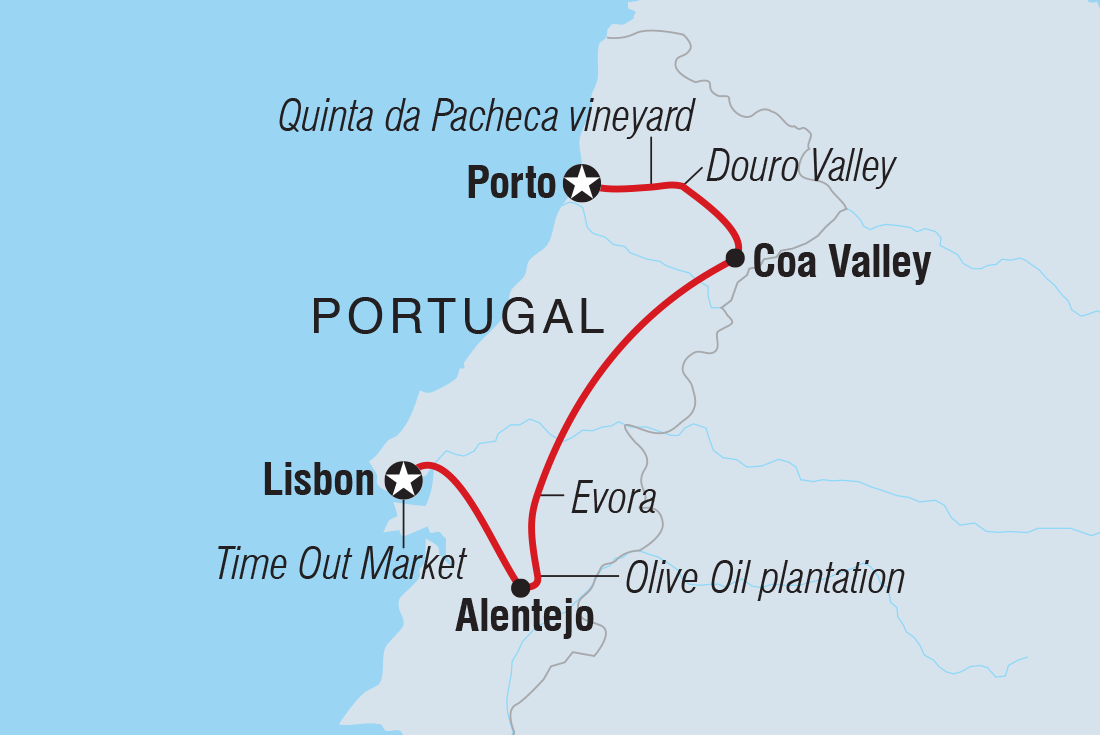Ola! Welcome to Portugal. Your adventure starts in Porto – a coastal city known for its medieval riverside district, azulejo tile-covered buildings and, of course, fortified port wine. You have a welcome meeting at 6 pm where you’ll meet your local leader and fellow travellers. After, get to know each other over an included dinner of one of Porto’s (and Portugal’s) favourite dishes – the francesinha. Although technically a sandwich, it’s most definitely a meal – and one you’ll need a knife and fork for! After, you could take an evening stroll along the river or grab a drink at one of the city’s many wine cellars.
Taste your way around Porto today while exploring the city’s old bridges, cobbled streets, merchants’ houses and cafes. Led by a local guide, you’ll start with coffee and pastel de nata (the famed Portuguese custard tart). Continue through the Ribeira District, sampling local specialties like bolinho de bacalhau (salted cod fritters) and a glass of wine, then pop into a classic tasco (bar) for a cachorrinho (Porto’s mini version of the hot dog) and a cold beer. Finish the tour at a traditional mercearia (family-run grocer) with a charcuterie board and a glass of port wine. You have free time for the rest of the day – maybe pull up a chair in a taverna and order another glass of port.
Take a scenic morning drive through the Douro Valley. Your first stop of the day is Quinta da Pacheca (winegrowers since 1738) for a guided tour, picnic lunch and wine tasting. Over a couple of glasses of local wine (and a port, of course), you’ll share an assortment of olives, sausages, fruits, salads, regional cheeses and more. Then continue to the Coa Valley – known for the combined efforts of passionate locals to rewild the area, starting with the reintroduction of ancient cow breeds. Your accommodation tonight is a homestay in the historic village of Castelo Rodrigo. Take some time to enjoy the views of the surrounding hills, then regroup for a home-cooked dinner showcasing local produce. You could also check out some of the Coa Valley’s open-air paleolithic rock art paintings nearby.
Say ciao to the Coa Valley and drive south to the medieval village of Marvao in the Alentejo region. Have lunch at a farm on arrival, then visit a local olive oil producer – this part of Portugal is known for its centuries-old olive groves. Walk around the factory and learn how this liquid gold is made before enjoying a tasting (a bottle of this stuff makes an excellent souvenir!). To round off the tour, you’ll plant an olive tree. Then continue the drive to your hotel in Castelo de Vide – considered one of Portugal’s best-preserved medieval towns. Relax or take some time to stroll the cobbled streets of the old Jewish quarter before enjoying an included dinner at the hotel.
Drive further south to Evora today. Evora is the capital of Alentejo and is steeped in history – as seen in the centrally located Roman Temple. Check out the highlights on an orientation walk with your leader, then enjoy free time for lunch. The city is famous for bread soup and pork clam stew – but just ask your leader if you need recommendations. Then it’s time to hit the road to Lisbon, arriving in the late afternoon. Take some time to freshen up, then regroup for an orientation walk of Portugal’s capital. Along the way, you’ll get to try ginjinha, a sweet cherry liqueur from Lisbon. The rest of the evening is free. Maybe ask your leader for authentic dinner options or check out a live fado show – a genre of Portuguese soul music that originated in Africa and has evolved to suit the streets of Lisbon.
Spend the morning exploring Mercado da Ribeira (aka Time Out Market) – a historic market with stalls selling fresh produce and artisanal goods, bars and even a cooking school. Then make a detour to Loja das Conservas – a quirky deco store selling canned fish from 17 different national canned fish outlets – for a tasting. You’ll then head to the Belem neighbourhood for a pastel de nata cooking class. First made in the 16th century by nuns, the mixture of crispy pastry and creamy egg custard filling is Portugal’s best-known dessert. If you have time, you might also want to stroll past the pastel-coloured buildings up to the Sao Jorge Castle – one of the city’s best views. As it’s your last night together as a group, you could head out for farewell dinner together and raise a toast to a brilliant week eating your way around Portugal.
With no activities planned, your trip comes to an end after breakfast. If you’d like to spend more time in Lisbon, just speak to your booking agent.


